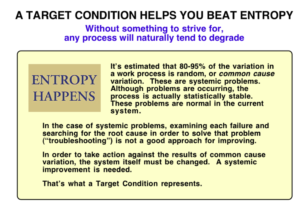This essay expands on the ideas introduced in its predecessor.
Per Rother, a Target Condition is a combination of a “desired outcome” and the “desired operating attributes that achieve that outcome.” “A Target Condition includes both of these elements and is therefore more than just an outcome goal.”
The Learner moves from their Current Condition (their current outcomes, and their current operating attributes) to the Target Condition by identifying and overcoming Obstacles, using PDCA cycles.
How is an Obstacle different from a Problem?
http://www-personal.umich.edu/~mrother/Handbook/TC.pdf

You problem-solve special cause variation. You do process improvement on common cause variation. If you are simply trying to achieve an outcome one time, then all you are worried about are problems. A door is closed, you open it. The door is locked, you bust it down. The door is made of steel, you get some explosives. Common cause and special cause variation only pertain to iterative processes. The concept of unwanted variation is meaningless if you aren’t aiming for consistent outputs over time.
For example: these essays—and the sentences in them—suffer from common cause variation. The characteristics of my process cause the variation in quality. I can always go back and revise—pick over each infelicity, each fuzzy idea and inaccuracy, and improve them, but that revision process would have its own characteristics and capability.
Maybe some improvement would result from the additional time spent identifying and removing defects. Another way of thinking of this is, my inputs to the process of revision would be further developed than the inputs to my process of drafting the document—the vague impressions floating around in my head.
It can be challenging to see how many of our desired outcomes are the results of processes. But isn’t thought a process?
I had been mistakenly confusing the concept of Obstacles over the past few weeks. I had been thinking that one could have Obstacles to desired outcomes, and to well-formed plans. But after going back to the Practice Guide, I realized that the definition of an Obstacle is precise. It is what keeps you from achieving a Target Condition, and a Target Condition must be a combination of desired outcomes and process characteristics. Why set Target Conditions?
One reason is to reduce common cause variation. Why do you want to reduce common cause variation? Because as you reduce common cause variation—when you raise the lower limit of your variation—you are able to increase the upper limit. But there is another reason. You can reduce your variation to six sigma without developing innovation for the customer. You can produce undesirable products of the highest consistency. Remember that you iterate through realized Target Conditions to a Challenge. A Challenge is just a description of your vision at a defined point in time. But your vision is based on what you actually want. What is actually valuable. What is actually better than reality right now. In order to move towards that, you have to have breakthroughs and discoveries, to develop in unforeseeable ways. Reducing common cause variation is a necessary component of that. If you sometimes get out of bed and sometimes don’t, you’re going to have a hard time. Even the most creative of professions require consistency. If you look into the processes of Chopin and Feynman, you won’t see them lounging about waiting for epiphanies.
When I started writing this essay, I thought I was going to explain a three-tiered model of Obstacles.
-
- Obstacles on just desired outcomes,
- Obstacles on drafting plans that can bear scrutiny, and Obstacles to implementing those plans,
- and true Obstacles to achieving Target Conditions.
But, as dealt with the problems as I found them, sentence by sentence, and by going back to the source material, I realized my thoughts had gone astray. Thank god for problems.
